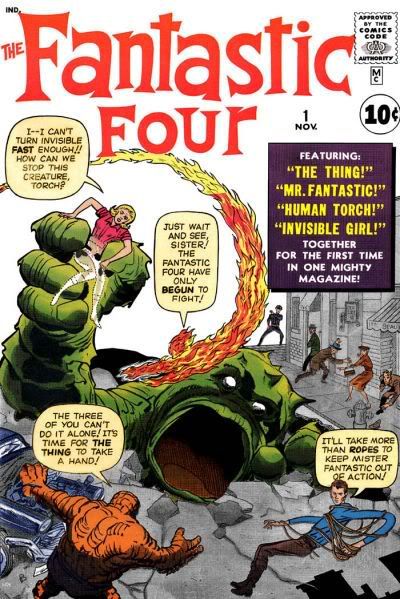 Hey Reed, Sue, Johnny and Ben! I love you guys! No matter what Marvel does to you, you'll always be the First Family of Comics.
Hey Reed, Sue, Johnny and Ben! I love you guys! No matter what Marvel does to you, you'll always be the First Family of Comics.
The Fantastic Four was not my favorite comic when I was a kid. I liked the Saturday morning cartoon versions, but it wasn't until my then-favorite artist, John Byrne, took over the magazine's writing and drawing that I started reading it. From what I remember of the letter pages, other readers felt Byrne recaptured the aura or specialness or mood of the Stan Lee-Jack Kirby era, and I wanted to know what that meant. If it meant stories about a group of people who obviously loved each other-- despite their occasional spats-- and household drama growing to cosmic proportions, along with a lot of creepy sci-fi-type menace, then I knew I had to somehow read those old issues.
But who had $1,500 to spend on a comic book? That was the going price for The Fantastic Four #1 at the time. I think. I bought a few cheap issues from late in Kirby's run as artist-- they looked dynamic and kind of slick, thanks to the Joe Sinnott ink polish, but the stories themselves didn't do a whole lot for me. They just seemed like the same tired stuff I was reading in other comics. Fist fights and villains in garish costumes. The hoary Marvel bombast courtesy Stan Lee: "If This Be Flatulence!" "By Arthropods Denied!" "If Thine Eye Offend Thee, Doctor Doom!" "A World Dies Screaming as Black Bolt Orders Pizza Pies!"
Marvel eventually reprinted the series in their Marvel Masterworks hardcovers-- which were also ridiculously expensive-- and then various other more affordable formats, so I was finally able to read the series from the beginning. The first few issues were crude, with rushed-looking art and clumsy stories. The characters were mere ciphers, barely more than stock types. The scientist, the girlfriend, the kid and the...
The Thing. That's what The Fantastic Four had going for it, right from the start. The Thing. Looks like a monster, has the broken heart of a man. And the stories began to improve. By issue #5-- the first appearance of longtime Marvel mainstay baddie Dr. Doom-- Stan the Man and Jolly Jack had gelled and the Marvel Era as we came to know it was born. Reed, Sue and Johnny became more believable as flawed individuals, their enemies original. From there things just got better and better. The book developed a tone unique among comics at the time, at least the ones I've read. I'm trying to avoid historical generalizations here, because I wasn't born until The Fantastic Four was almost seven years old and I'm hardly a historian.
But you know what I mean. The marriage of the superheroic with the supermundane. One minute Reed Richards would be espousing some idiotic theory with Sue Storm petulantly demanding he spend more time snuggling with her, the next the Thing and Johnny Storm would be tearing up the place with their interminable sibling warfare. And then and only then would the issue's menace appear. Dr. Doom again. An alien child. The Skrulls. The Impossible Man. Irving Forbush. Danny Kaye. The New York Mets.
Despite his having been an established pro since the 1930s, it was during this time Kirby's art took on its characteristic visual power and he became the Kirby we know and love today. By the time Chic Stone took over on inks, Kirby had established himself as the King of Comics. Then came Joe Sinnott and his more polished finish and you had the Marvel House Style, a visual lexicon that matched Stan Lee's endless hyping and hucksterism-- the kind of comedic self-aggrandizing style that's so much fun to parody. 1940s army slang mixed with beatnik expressions and Madison Avenue ad-man copy, the occasional foray into Shakespearian syntax. 'Nuff said, True Believers!
The ideas began to flow at a feverish pace. I can't even keep them in order! The Inhumans, The Watcher, Silver Surfer, Galactus, the Blue Area on the Moon. The Yancy Street Gang. Wyatt Wingfoot. Alicia Masters, the gentle, blind sculptor whose love for Ben Grimm made the poor guy's life even more beautifully tragic. It seemed like every issue of The Fantastic Four was in danger of exploding from the pressure of too many concepts and characters against the thin skin of the gray newsprint they were printed on. How could one slender comic book contain so much? Look out! IT'S GONNA BLOW!
And finally, it did. Lee and Kirby began repeating themselves and soon Kirby was off at DC creating a new universe. But let me tell ya, the first 51 or so issues of The Fantastic Four are pop art masterworks. The encapsulate a lot of the vibrancy of the 60s. Watching Lee and Kirby grow into their creative powers issue by issue is a lot like listening to the Beatles' recorded catalog from beginning to end. The comics are very much of their time and in that, they're timeless.

No comments:
Post a Comment